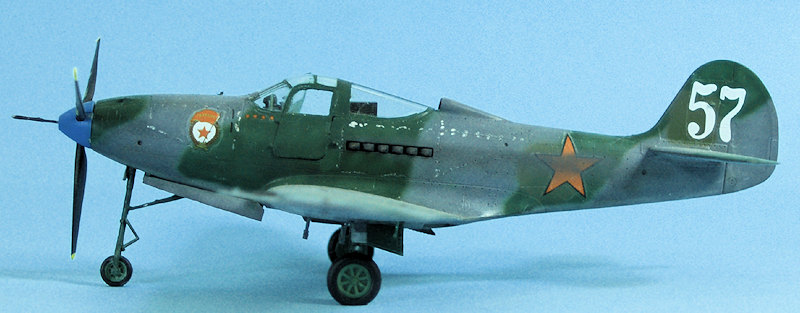
| KIT #: | 09758 |
| PRICE: | $17.95 on sale |
| DECALS: | Three options |
| REVIEWER: | Tom Cleaver |
| NOTES: |

| HISTORY |
The Airacobra I was an export version of the P-39 very similar to the P-39D, other than the 37mm Oldmobile cannon was exchanged for a 20mm Oerlikon. The Airacobra I went operational with 610 Squadron in the fall of 1941, where it was quickly discovered that the Airacobra did not meet the requirments of air combat over western Europe.
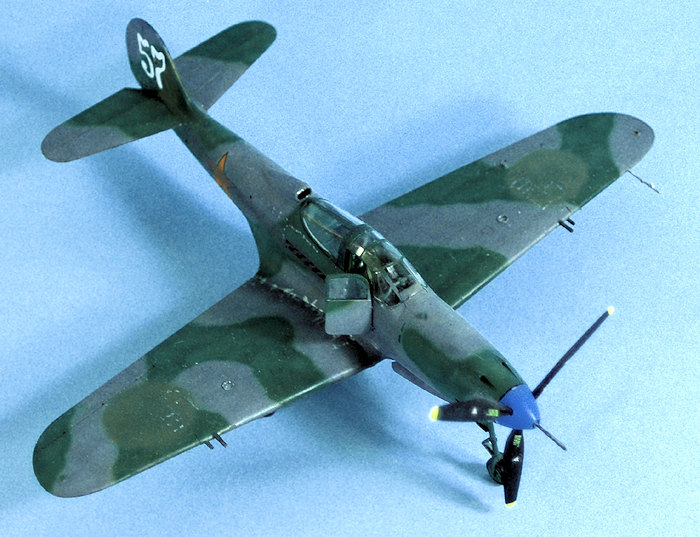 The USAAF took over
all undelivered Airacobra Is after Pearl Harbor, designating them as P-400s.
Most ended up in the South Pacific or New Guinea. The Airacobra Is that had been
delivered to Britain were sent to the USSR with the first delivery in December
1941 and further deliveries through to June 1942, for a total of 212 aircraft.
These supplemented US deliveries of the P-39D-2 under Lend-Lease. The arrival of
these 212 aircraft beginning in the spring of 1942 was very timely.
The USAAF took over
all undelivered Airacobra Is after Pearl Harbor, designating them as P-400s.
Most ended up in the South Pacific or New Guinea. The Airacobra Is that had been
delivered to Britain were sent to the USSR with the first delivery in December
1941 and further deliveries through to June 1942, for a total of 212 aircraft.
These supplemented US deliveries of the P-39D-2 under Lend-Lease. The arrival of
these 212 aircraft beginning in the spring of 1942 was very timely.
The crated Airacobras were unloaded in Murmansk and went directly to the active aviation units of the VVS Northern Fleet of the 78th IAP, or were transported by rail to the Karelian Front where they were issued to the 19th Guards IAP. The Airacobras served primarily on the Arkangel and Leningrad Fronts.
Test flying revealed the Airacobra had excellent speed and maneuverability at the altitudes at which most combat over the Eastern Front occurred and that the airplane could be flown by pilots of average ability with less than 20 hours of training in type. The tendency to enter a flat spin was the one bad flight area. It would not be until the aircraft entered operational service that the tendency of the Allison engine to throw connecting rods would be discovered. It was decided that the Airacobra would only be issued to units with combat experience so that the pilots could make the best use of it quickly.
The Airacobra first entered combat with the 2d Guards Mixed Air Regiment of the AV/MF, the Soviet Naval Air Force, at Murmansk in late February 1942. The unit flew I-16s, Hurricanes and Kittyhawk II fighters in defense of the convoys coming to Murmansk and the port.
The first VVS unit to transition to the Airacobra I was the 145th IAP, which they did in March 1941 at their operational airfields without any instruction manuals. The unit entered combat over Arkangel in early April 1941 and was soon successful as bomber interceptors. Effectiveness grew as the pilots became more familiar with the aircraft. For example, on 15 June six 6 Airacobras intercepted six bombers and 16 escorting Bf 110 fighters in the area of Murmashy airfield, headed toward Murmansk. In the engagement that followed, nine German aircraft were shot down without loss.
 Two fighter
regiments, the 153rd and 185th IAPs, were formed on Airacobra Is in the course
of 1942. The 153d IAP arrived for re training from the Leningrad Front on 25
March 1942. The re training of the unit took 27 days, with an average of 12
flight hours per pilot. By 10 June 1942 the regiment had completed transition
and on 14 June was sent to Voronezh Front, composed of two squadrons with 20
aircraft and 23 pilots each, under the command of Hero of the Soviet Union Major
S. I. Mironov, arriving on 29 June 1942. In July the regiment relocated to
Lipetsk airfield, from which it operated until 25 September 1942. In 59 flying
days on the Voronezh Front the regiment conducted 1,070 combat sorties with 1162
hours of flight time; fought 259 aerial engagements, of which 45 were of a group
nature; shot down 64 enemy aircraft, of which 18 were bombers (15 Ju 88, 1
Do 217, 1 He 111, and 1 FW 198), 45 fighters (39 Bf 109F, 1 Bf 110, 1 Me 210, 4
MS 200), and 1 aerial observation aircraft. Losses during these three months of
combat were 3 pilots and 8 aircraft. On 22 November 1942 the 153rd IAP received
the Guards title and was renamed the 28th Guards IAP. In November 1943 the
regiment received the honorific title "Leningradskiy" (28th Guards "Leningradskiy"
IAP). They exclusively flew the Airacobra I until August 1943 when they began to
receive P-39N and P-39Q aircraft through Lend-Lease.
Two fighter
regiments, the 153rd and 185th IAPs, were formed on Airacobra Is in the course
of 1942. The 153d IAP arrived for re training from the Leningrad Front on 25
March 1942. The re training of the unit took 27 days, with an average of 12
flight hours per pilot. By 10 June 1942 the regiment had completed transition
and on 14 June was sent to Voronezh Front, composed of two squadrons with 20
aircraft and 23 pilots each, under the command of Hero of the Soviet Union Major
S. I. Mironov, arriving on 29 June 1942. In July the regiment relocated to
Lipetsk airfield, from which it operated until 25 September 1942. In 59 flying
days on the Voronezh Front the regiment conducted 1,070 combat sorties with 1162
hours of flight time; fought 259 aerial engagements, of which 45 were of a group
nature; shot down 64 enemy aircraft, of which 18 were bombers (15 Ju 88, 1
Do 217, 1 He 111, and 1 FW 198), 45 fighters (39 Bf 109F, 1 Bf 110, 1 Me 210, 4
MS 200), and 1 aerial observation aircraft. Losses during these three months of
combat were 3 pilots and 8 aircraft. On 22 November 1942 the 153rd IAP received
the Guards title and was renamed the 28th Guards IAP. In November 1943 the
regiment received the honorific title "Leningradskiy" (28th Guards "Leningradskiy"
IAP). They exclusively flew the Airacobra I until August 1943 when they began to
receive P-39N and P-39Q aircraft through Lend-Lease.
The 19th Guards IAP transitioned to the Airacobra in August 1942 and was involved in heavy combat throughout the rest of the year on the Leningrad front. The unit began to receive P-39Ns in February 1943 through Lend-Lease, but the last Airacobra I was used until March 1944.
In December 1942, the commander of the 28th Guards IAP reported on the unit’s combat experience in the Voronezh and West Fronts in July August 1942: "The Airacobra aircraft is considered by the Germans to be the most dangerous enemy and should be engaged in combat only when they [the Germans] have numerical superiority and the advantage in altitude and surprise."
The Airacobra I may not have worked over France and might have been a distant second choice for pilots at Guadalcanal or Port Moresby, but over Murmansk and Leningrad, it established the good reputation the P-39 would have with the Red Air Force for the rest of the war.
| THE KIT |
When the Hasegawa
Airacobras were announced in 2006, many questioned why the company had decided
to do the P-39, since Eduard had already released good kits of it, and ev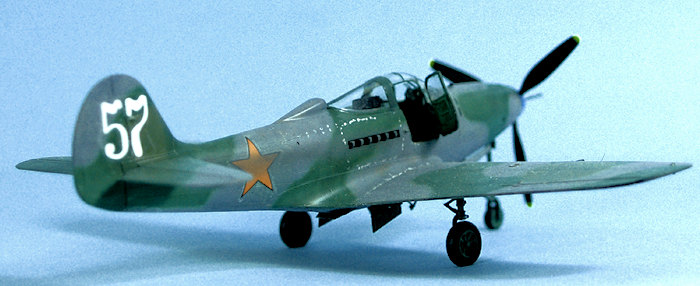 en the
old Monogram kit originally released in 1969 was still very acceptable.
en the
old Monogram kit originally released in 1969 was still very acceptable.
In fact, Hasegawa created a kit that is superior to the existing kits. Instead of the raised detail of the Monogram kit, it has fine recessed detail. Unlike the Eduard kit, which has an overly thick trailing edge on the wing, the Hasegawa kit has knifeblade trailing edges. Some modelers have suggested the rudder might not be the correct shape, but whatever dimensional imperfections may exist there are minor.
Both Eduard and Monogram have done nice cockpits in their kits, but in both cases resin replacements are superior. The Hasegawa kit has a cockpit that is much better detailed than either of the others, needing only photoetched seat belts to add sufficient detail. So, when I found one on consignment sale at the LHS for only $17 (one-third what the kit sells for nowadays), it wasn’t hard to say “yes.”
| CONSTRUCTION |
The kit is extremely well designed and really does “fall together.” After the detail parts are pre painted, the entire assembly can be accomplished in a matter of a few hours, and no problems are presented as regards fit.
I pre painted the
detail parts, these being the cockpit, gear wells, landing gear and gear doors,
which are all done in “Bell Green.” Having seen the very accur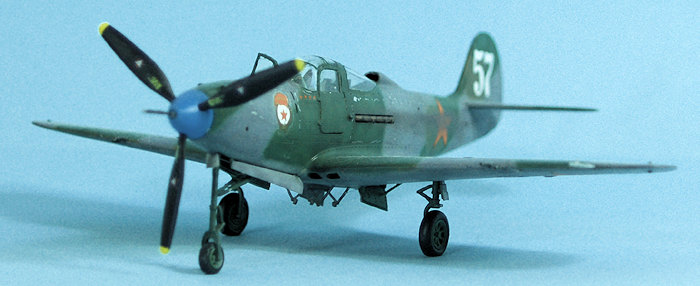 ate P 39
restoration at Yanks Air Museum in Chino, I can assure you that this color is US
Medium Green nothing special or out of the ordinary, other than it
being a different color from interior green which was used by most other
manufacturers. You can use any available Medium Green you want for this. In my
case, I used Xtracrylix Medium Green.
ate P 39
restoration at Yanks Air Museum in Chino, I can assure you that this color is US
Medium Green nothing special or out of the ordinary, other than it
being a different color from interior green which was used by most other
manufacturers. You can use any available Medium Green you want for this. In my
case, I used Xtracrylix Medium Green.
When all this was dry, I applied the very nice instrument panel decals to their parts. While that was setting up, I made seat belts from lead foil and put them on the seat.
I assembled the wing with no problems, and then the fuselage. The only place I used any Mr. Surfacer was on the fuselage to be sure I got rid of the centerline seam. I crammed as many fishweights as possible in the nose, but left the top panel off until I could assure myself there was enough to insure nose-sitting. As it turned out, I needed one more. I suggest you do the same when building this kit.
| COLORS & MARKINGS |
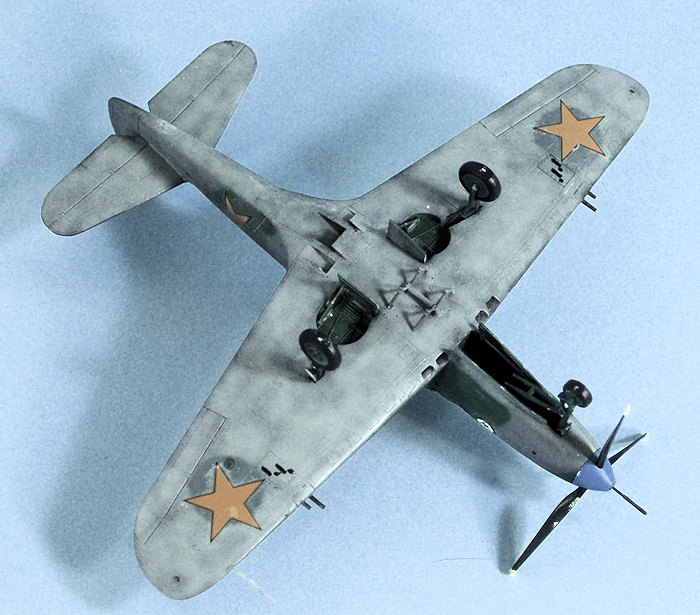 The Airacobra Is were
delivered to the RAF in Dupont Dark Earth (a different shade than RAF Dark
Earth) and Medium Green upper surfaces and a Light Grey lower surface. The
British then painted the Airacobras with RAF Ocean Grey before they went
operational, and the airplanes were all delivered in this scheme to the USSR. I
used Tamiya Ocean Grey and Medium Green for the upper colors and Sky Grey for
the lower.
The Airacobra Is were
delivered to the RAF in Dupont Dark Earth (a different shade than RAF Dark
Earth) and Medium Green upper surfaces and a Light Grey lower surface. The
British then painted the Airacobras with RAF Ocean Grey before they went
operational, and the airplanes were all delivered in this scheme to the USSR. I
used Tamiya Ocean Grey and Medium Green for the upper colors and Sky Grey for
the lower.
I used decals from several old sheets in the Decal Dungeon to come up with the red stars, tail number and Guards insignia to do an Airacobra of the 28th Guards IAP.
Since these airplanes saw hard service, I dinged the model and applied heavy exhaust stains. I cut off the lower main gear doors, as I found several photos of the airplanes with the doors removed for operation from muddy Russian airfields.
| CONCLUSIONS |
I still consider the Hasegawa P-39 the best kit out there in 1/48 of this interesting airplane. I have seen several limited-release kits available at the new expensive Hasegawa prices, but if you find one at a show you may get lucky as I did.
25 August 2016
Copyright ModelingMadness.com
Review kit courtesy of my wallet.
If you would like your product reviewed fairly and fairly quickly, please contact the editor or see other details in the Note to Contributors.